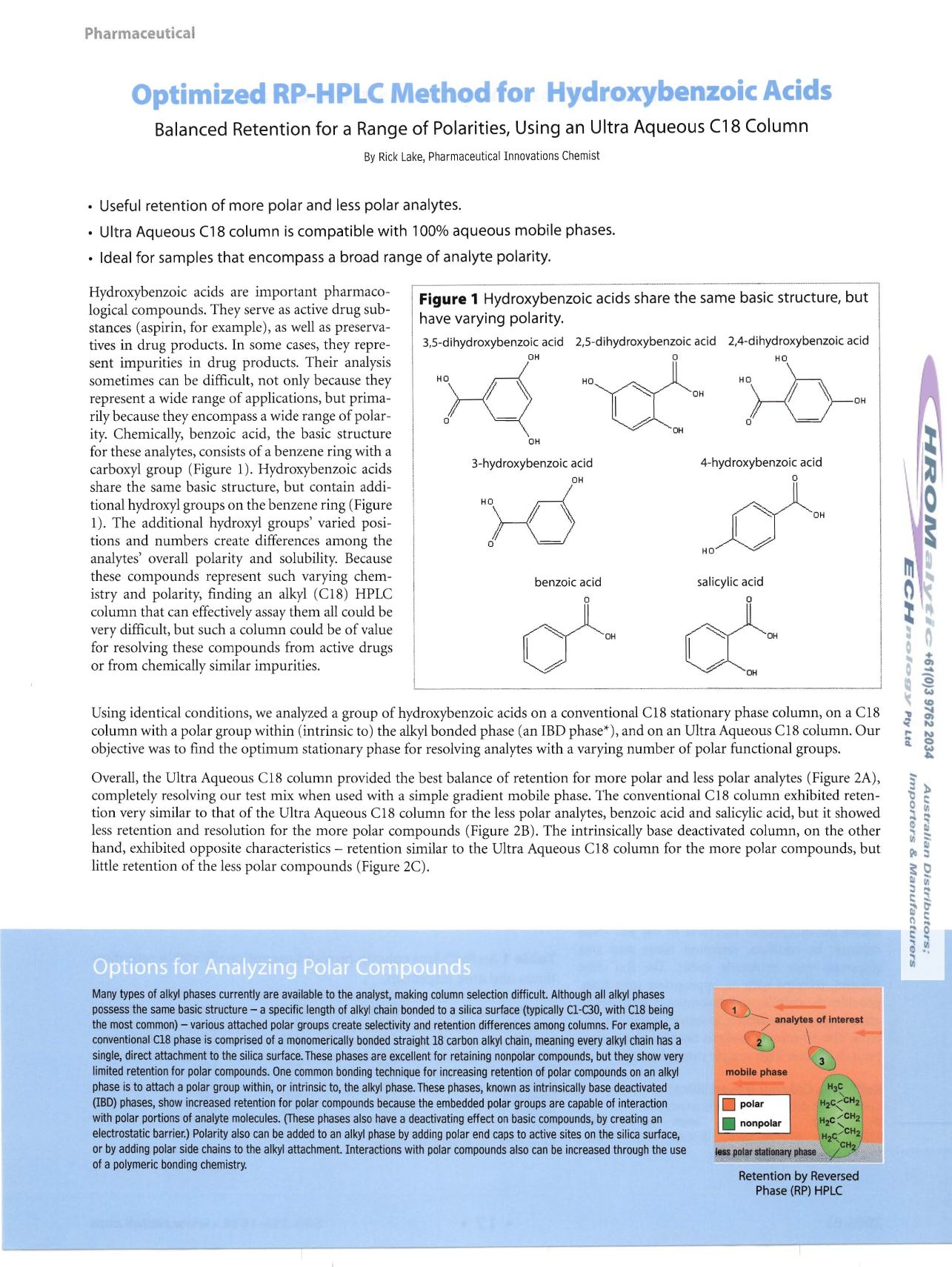

Pharmaceutical
Optimized RP-HPLC Method for Hydroxybenzoic Acids
Balanced Retention for a Range of Polarities, Using an Ultra Aqueous C18 Column
By Rick Lake, PharmaceuticalInnovations Chemist
Useful retention of more polar and less polar analytes.
• Ultra Aqueous (18 column is compatible with 100% aqueous mobile phases.
• Ideal for samples that encompass a broad range of analyte polarity.
Hydroxybenzoic acids are imp ortant pharmaco
logical compounds. They serve as active drug sub
stances (aspirin, for example ), as well as preserva
tives in dru g products. In some cases, they repre
sent impurities in dru g products. Their analysis
sometimes can be difficult, not only because they
represent a wide range of applications, but prima
rily because they encompass a wide range of polar
ity. Chemically, benzoic acid, the basic structure
for these anaIytes, consists of a benzene ring with a
carboxyl group (Figure 1). Hydroxybenzoic acids
share the same basic structure, but contain addi
tional hydroxyl groups on the benzene ring (Figure
1). The additional hydroxyl groups' varied posi
tion s and numbers create differences amo ng the
analytes' overall polarit y and solubility. Because
these compounds represent such varying chem
istry and polarity, findin g an alkyl (CIS) HPLC
column that can effectively assay them all could be
very difficult, but such a column could be of value
for resolving these compounds from active dru gs
or from chemically similar impurities.
Figure 1
Hydroxybenzoic acids share the same basic structure, but
have varying polarity.
3,S-dihydroxybenzoic acid 2,S-dihydroxybenzoic acid 2A-dihydroxybenzoic acid
OH
O
HOlXOH
") <
~
I
~
#
OH
OH
3-hydroxybenzoic acid
4-hydroxybenzoic acid
o
") <)"
~O"
HO~
benzoic acid
salicylic acid
o
~oo
d'oo
~OH
Using identical conditions, we analyzed a group of hydroxybenzoic acids on a conventional CIS stationary phase column, on a CIS
column with a polar group within (intrinsic to) the alkyl bonded ph ase (an IBD ph ase"), and on an Ultra Aqueous CIS column. Our
objective was to find the opt imum stationary phase for resolving analytes with a varying number of polar functi onal groups.
Overall, the Ultra Aqueous CIS column provided the best balance of retention for more polar and less polar analytes (Figure 2A),
completely resolving our test mix when used with a simple gradient mobile phase. The conventional CIS column exhibited reten
tion very similar to that of the Ultra Aqueous CIS column for the less polar analytes, benzoic acid and salicylic acid, but it showed
less retenti on and resolution for the more polar compounds (Figure 2B). The intrins ically base deactivated column, on the other
hand, exhibited opposite characteristics - retention similar to the Ultra Aqueous CIS column for the more polar compounds, but
little retention of the less polar compounds (Figure 2C).
Many types of alkyl phases currently areavailable to theanalyst, making column selection difficult. Although all alkyl phases
possess thesame basic structure - a specific length ofalkyl chain bonded to a silica surface (typically
Cl-OO,
withC18 being
themost common) - various attached polar groups create selectivity and retention differences among columns. Forexample, a
conventional C18 phase is comprised of a monomerically bonded straight 18carbon alkyl chain, meaning every alkyl chain has a
single, direct attachment to thesilica surface.These phases areexcellent for retaining nonpolar compounds, butthey show very
limitedretention for polar compounds. One common bonding technique for increasing retention of polar compounds on analkyl
phase isto attach a polar group within, or intrinsic to,thealkyl phase.These phases, knownasintrinsically base deactivated
(IBD) phases, show increased retention for polar compoundsbecause theembedded polar groups arecapable of interaction
withpolar portions of analyte molecules. (These phases also have a deactivating effect onbasic compounds, bycreating an
electrostatic barrier.) Polarity also can beadded to analkyl phase byadding polar end caps to active sites onthesilica surface,
or byadding polar side chains to thealkyl attachment. Interactions with polar compounds also can beincreased through theuse
of a polymeric bonding chemistry.
Retention by Reversed
Phase (RP)
HPLC
Website :
www.chromtech.net.auE-mail :
info@chromatech.net.auTelNo : 03 9762 2034 . . . in AUSTRALIA











